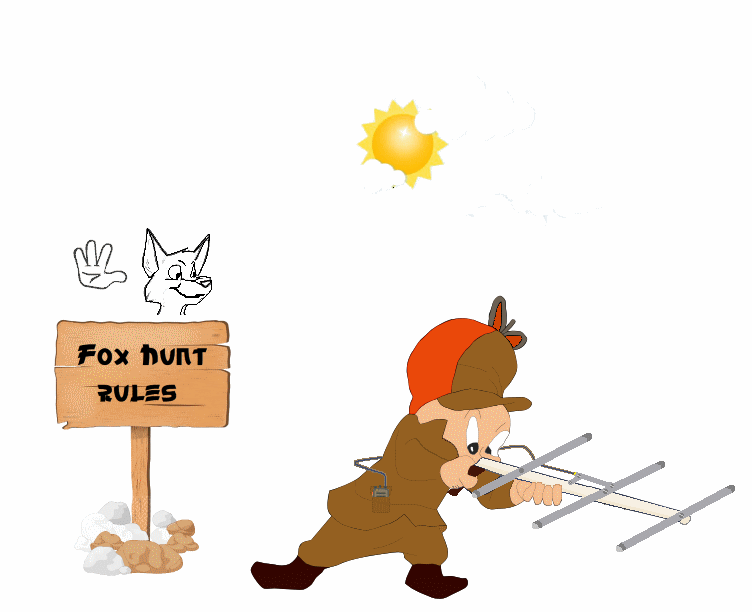
Fox Hunting
Radio direction finding (also T-Hunting, Fox Hunting, or Bunny Hunting) is used to find sources of interference to any form of wireless electronic communications, including broadcast and two-way radio. Locator Transmitters in downed aircraft are tracked with RDF techniques. Hams use RDF to track jamming stations and stolen equipment, but more often, they use it just for fun. Hidden transmitter hunting has been done by hams for about 50 years and it is a growing activity. Using ‘hide-and-seek” procedures, a growing number of ham radio operators have taken up the task of finding hidden transmitters (known as the “Fox”). Since this involves only the reception of signals by the trackers (the Hounds), unless you are transmitting on a general discussion frequency Fox Hunting does not require a ham radio license to participate. Therefore, it is becoming a popular family activity as well. Sometimes the event will be held on foot, while other times the beginning distance between the Fox and the Hounds necessitate the use of a vehicle. Sometimes the “Fox” may be disguised to make the hunt more difficult, so watch out for “Wolves” when you are hunting too. Whatever the case, it is a fun activity! If you do not have the necessary equipment but would like to know more about this fun “radiosport”, we will team you up with equipped members for the hunt.
Fox Hunt Rules Purposes
- Provide practice and enhance skill in radio direction finding for and by radio amateurs.
- Promote teamwork within the amateur community.
- To help or “Elmer” newcomers and old-timers alike in the skills of radio direction finding.
- Make available a competent pool of people with the skills for finding the source of intentional or unintentional radio interference.
- Have fun!
Suggested rules for a Fox Hunt
- The starting place, date and time (including finishing time) should be determined and widely communicated to all participants.
- The boundaries of the hunt should be determined and widely communicated to all participants.
- Transmitters should be on the air at the same time and should be readable from the starting point.
- Unless otherwise notified and widely communicated to all participants, the hidden transmitter’s signal should be able to be received at the starting point utilizing an antenna with no more than 6db gain.
- There should be one simplex frequency for the transmitter and another for general discussion.
- The hidden transmitter should use a constant power level during the hunt and the transmitter antenna configuration should not change.
- In an emergency, any station may ask for help on either transmit frequency and then change to the frequency for general conversation. The hunt should be discontinued until the emergency no longer exists.
- The transmitter should be no more than 2m above ground level and not below ground level.
- The Fox shall tell the hounds when to begin the hunt.
- Individuals or teams should be allowed participate in the hunt.
- Each team should travel together in a single vehicle.
- The hidden transmitter should be within 100 meters of a public road and must be accessible to the public with no admission fee required.
- The transmitter should not be hidden in a building so that all teams and individuals can hunt with equally high enthusiasm.
- The hunters who find the fox should not announce they have found it so as not to spoil the hunt for the remaining participants.
- At the expiration of the finish time, the end of the hunt should be announced on the FOX frequency.
- All hunter teams are to observe all traffic laws and are to respect the property rights of all property owners. Violations should be grounds for disqualification from the hunt.
- Rules may be modified for a particular hunt. If modified, the applicable rules for the hunt should be widely communicated to all participants prior to the start of the hunt.
Suggested Basic Equipment
- 2-meter handheld radio or scanner
- Directional Antenna
- Attenuator
Advanced Equipment
Local map and compass or a GPS device.
Non-Scored Hunts
The objective of these hunts is to find the Fox without competing against others. This gives newcomers a no pressure situation where they can take their time to learn more about their equipment and using new techniques.
Scoring for the hunters
For safety reasons, the quickest time should not be used in hunts as a means of scoring. The individual or team with the lowest mileage (to the nearest 1/10th km) could be declared the winner. Scaling up to the longest distance travelled as a means of scoring.